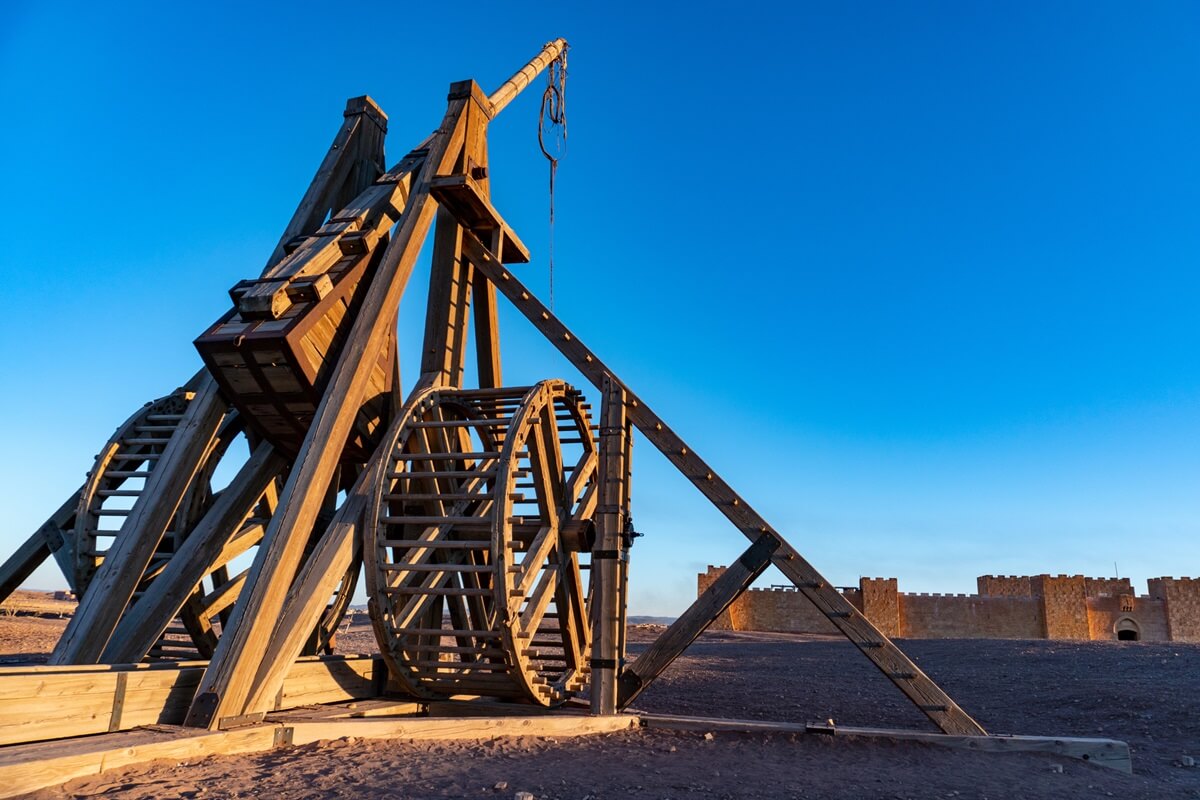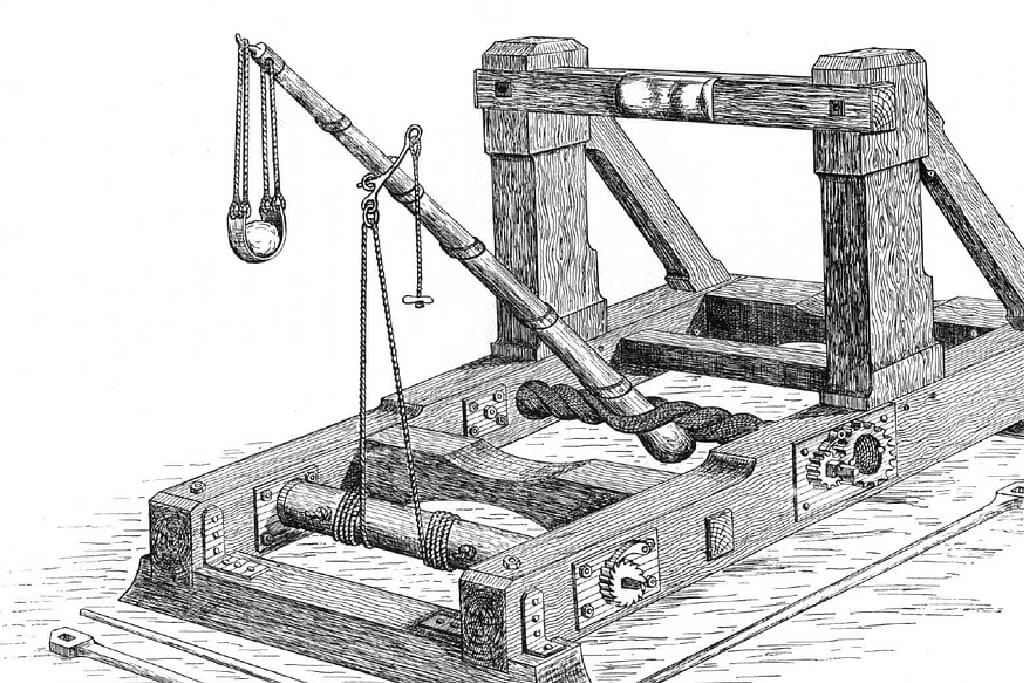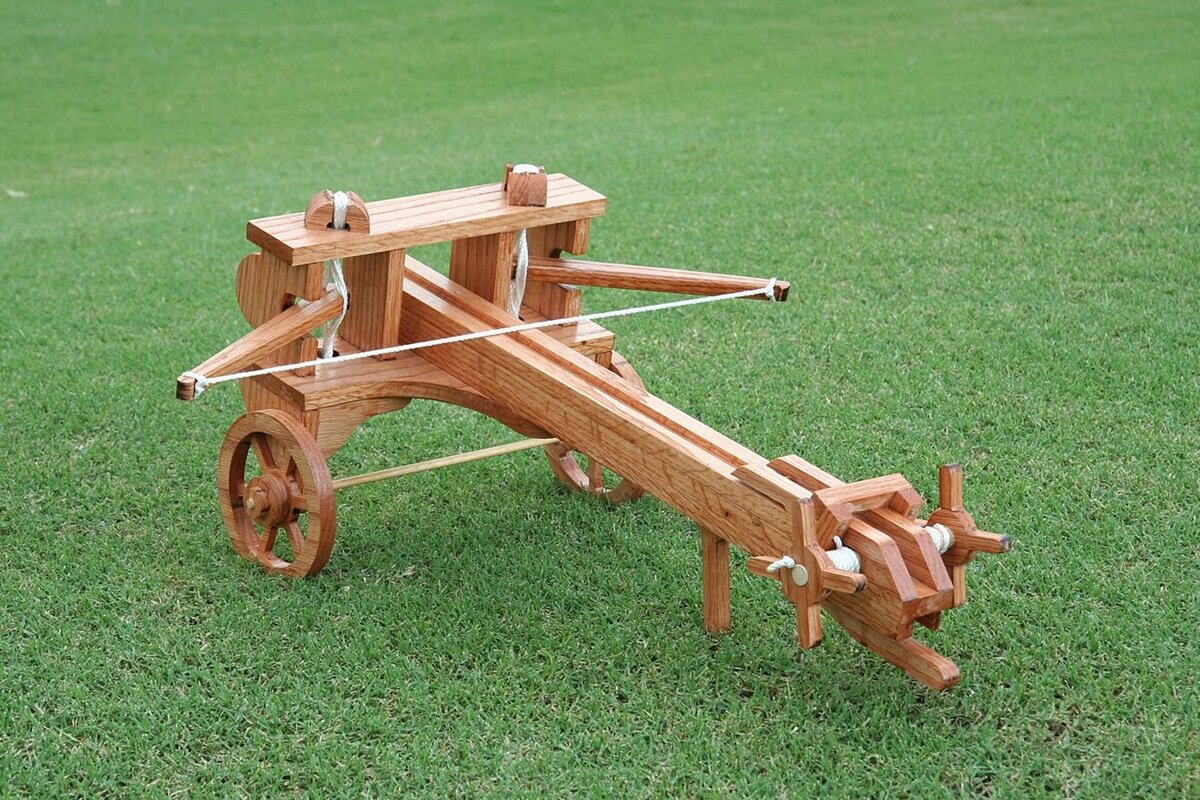Introduction
Roman catapults were formidable siege engines, emerging during the 4th century BC. They marked a significant advancement in ancient warfare technology due to their enhanced power, range, accuracy, and versatility.
The development of various types of catapults, capable of launching heavy projectiles from a distance, revolutionized siege tactics and had a profound psychological impact on the enemy, setting the stage for further advancements in military technology.
Evolution of Catapult Technology in Ancient Rome
Catapults are believed to have been originally invented by the ancient Greeks. According to the Greek historian Diodorus Siculus, the catapult was invented around 399 BC by ancient Greek engineers. More specifically, Dionysius the Elder of the Greek city of Syracuse is credited with building the first catapult circa 400 BC, inspired by the design of the crossbow.
The Greeks continued to develop and refine catapult technology, such as the "palintonos" (V-spring) catapult, invented by Alexander the Great's engineer Diades of Pella in the 4th century BC, which was the first big stone thrower in human history.
Also during the 4th century BC, Philip II of Macedon - father of Alexander the Great - harnessed the power of torsion springs in the development of siege towers and artillery weapons. These early Greek designs laid the foundation for the Roman catapults.
The Greeks' understanding of mechanics and rate of fire influenced Roman engineers, who studied and improved upon these concepts. The Romans later adopted and further enhanced catapult designs, using various types including the onager, ballista, and scorpio, each employing different motive forces such as tension and torsion. They made changes to the materials used and design tweaks which allowed them to achieve better range, power and accuracy than before.
As the Roman Empire expanded, so did the reach of its engineering marvels. The deployment of catapults became a symbol of Roman military prowess, with their construction and operation becoming a specialized field within the legion's ranks. The single-armed onager, designed for hurling stones, became a dominant siege weapon during the time of the Roman Empire.
Roman engineers meticulously calculated the physics behind each device to optimize its performance on the battlefield. This application of physics and engineering principles laid the groundwork for the siege engines that would later come to dominate medieval warfare. As alluded to above, the legacy of these siege engines would endure well beyond antiquity, influencing warfare and engineering for millennia.
Types of Roman Catapults and Siege Engines
The Onager
The onager, a powerful Roman siege weapon, was named after the wild ass for its mighty kick. This catapult functioned through a single-arm torsion mechanism that flung stones with raw power. The onager's design allowed it to hurl heavy projectiles over walls, wreaking havoc upon enemy fortifications and troops.
Operated by skilled engineers and soldiers, onagers were a staple in the Roman Empire's artillery arsenal. Their ability to cause destruction from afar changed the dynamics of warfare, giving the Romans a formidable edge in sieges.
The Ballista
The ballista, another key artillery weapon within the Roman army's array, was renowned for its precision in launching projectiles. Resembling a giant crossbow, the ballista utilized torsion springs made from twisted ropes or animal sinew to propel bolts or stones at enemy targets. This level of accuracy allowed the Romans to eliminate specific threats on the battlefield, including enemy siege equipment and personnel.
Evolving throughout the Roman Empire, ballistae became more sophisticated and were often mounted on movable platforms for increased tactical flexibility. The precision strikes of the ballista disrupted enemy formations and provided cover for advancing Roman legions.
The Carroballista
The carroballista combined the power of a ballista with the mobility of a cart. This mobile artillery unit featured a metal frame and torsion springs made from coils of rope or animal sinew, which acted as springs. The weapon was mounted on a cart, allowing for rapid deployment and repositioning on the battlefield.
The Scorpio
The scorpio (scorpion) was a smaller, but no less deadly, Roman artillery weapon, with a range of around 100 meters. Encased in a metal-plated box, the scorpio's power also came from torsion springs made from coils of rope or animal sinew. This device, consisting of a stock attached to the metal frame, was capable of firing bolts at a high velocity, providing the Roman army with a lethal tool for precision targeting at closer ranges.
With its compact size, the scorpion could be easily maneuvered and deployed in various combat scenarios. Its metal frame and components ensured durability, while the tension in its torsion springs allowed for rapid bolt release. This combination of portability and firepower made the scorpion a feared presence on the battlefield.
The Siege of Alesia
The Siege of Alesia in 52 BC is one example of the Roman military’s successful use of siege engines, when Julius Caesar's forces surrounded the Gallic stronghold with both offensive and defensive fortifications. Central to this feat were catapults which provided continuous bombardment, hindering the efforts of Gallic reinforcements and demoralizing the besieged. The relentless assault by Roman artillery, such as the ballista, proved a significant contributory factor in Caesar's victory.
Moreover, the siege's success depended on the strategic placement and operation of these engines, demonstrating the Romans' mastery in integrating artillery into their comprehensive military tactics. The victory at Alesia, aided by the lethal efficiency of Roman siege engines, cemented Caesar's reputation as a military genius and highlighted the critical role of catapults in ancient warfare.
The Construction and Operation of Roman Catapults
The construction of Roman catapults was a meticulous process that combined skilled craftsmanship with robust materials. Engineers in the 4th century BC sourced quality timber and forged strong iron components to create the framework of these formidable machines. Tight ropes made from animal sinew or hair provided the necessary tension to propel projectiles with deadly force.
Roman catapults were constructed using a variety of materials meticulously chosen for their properties. Durable woods like oak and ash formed the core of the structure, while tightly twisted sinew provided the torsion needed for launching projectiles. Metals were employed strategically; iron and bronze were common choices for reinforcement and mechanical components.
The craftsmanship involved was a result of empirical knowledge and innovation passed down through generations.
Design tweaks were continuously applied to enhance performance. For instance, the onager's sling was refined to increase range and power. The addition of metal plates improved the structural integrity of the ballista's arm. These enhancements may appear minor, and yet they significantly boosted the machine's efficiency, a reflection of the Romans' dedication to engineering excellence and continuous improvement.
Training and Battlefield Coordination
Operating a Roman catapult required a specialized team, trained in both the mechanics of the siege engines and the strategies of warfare. Each member had a specific role, from loading the projectiles to adjusting the tension for accurate firing. Coordinated efforts were essential, with teams working in unison to achieve a relentless barrage against enemy fortifications.
Coordination extended beyond the crew to battlefield commanders, who integrated catapult deployment into broader tactical plans. Decisions on when and where to unleash the catapults' power could turn the tide of battle.
Archaeological Discoveries and Reconstructions
Archaeological excavations have unearthed remnants of Roman siege engines, providing insight into their construction and use. These findings are crucial for historians and engineers seeking to understand the evolution of ancient military technology and just how Roman catapults and siege engines actually worked in practice.
Reconstructions of Roman catapults, based on ancient texts and archaeological evidence, have allowed modern scholars to experimentally test their capabilities. Since the 19th century, historians have pieced together the functions and designs of these weapons from fragmented remains. The analysis often involves a multidisciplinary approach, combining historical accounts with material science to reconstruct an accurate picture of Roman siege tactics and engineering expertise.
Scholars like Eric Marsden have led efforts to recreate Roman catapults, using historical texts and archaeological findings as guides. These reconstructions not only validate ancient descriptions but also provide hands-on experience of the engineering principles behind these formidable weapons.
Modern reconstructions often incorporate metal plates in areas that would have experienced significant stress, adhering to the principles inferred from ancient designs. These projects have allowed historians and engineers to test theories about range, power, and operation.
Catapults After The Romans
Following the fall of the Roman Empire, the legacy of their catapults and siege technology persisted throughout the medieval period. These machines inspired new generations of engineers and military tacticians who adapted and refined the designs to suit their own needs. The Roman approach to siege warfare set a standard that would influence military strategies for centuries.
As trade and communication networks expanded, so did the exchange of knowledge regarding siege technology. Roman catapults served as a foundation for further innovation, demonstrating the lasting impact of their engineering feats on the art of warfare and beyond.
Medieval Adaptations of Roman Siege Technology
The medieval period saw a resurgence of Roman siege technology as European powers sought to fortify their territories and expand their domains. Roman designs were studied and adapted, with changes made to suit the materials and military tactics of the time. The trebuchet, for instance, evolved from the principles of the Roman onager, but used a counterweight system to launch projectiles.
These adaptations were not mere copies; they were enhancements that reflected the evolving nature of warfare. Medieval engineers borrowed from the Romans, just as the Romans had done from the Greeks.

A trebuchet in the Sahara desert, Morocco
The Cultural Iconography of Ancient Artillery
The image of these siege weapons has been romanticized in literature and art, not least by figures such as Leonardo da Vinci, who sketched designs for catapults and other war machines, drawing inspiration from classical sources.
The cultural impact of these ancient artillery pieces is evident in their portrayal in films and video games, symbolizing the might and sophistication of the Roman military. They serve as reminders of a time when the power to conquer was often decided by the range and accuracy of one's siege engines.
Hands-on Learning: Recreating Roman Engineering
Educators and enthusiasts alike engage in hands-on projects to recreate Roman engineering marvels, including catapults. These activities provide a tangible connection to the past and offer a unique opportunity to understand the principles of physics and mechanics that the Romans mastered. DIY catapult kits are popular tools for learning, allowing students to construct their own miniaturized versions of these ancient machines.
The challenges in creating authentic replicas lie in the details, such as understanding the tension needed in the torsion springs or the precise angle for maximum projectile distance. Through these educational projects, learners can appreciate the complexity and effectiveness of Roman siege engines and the engineering knowledge needed to create them.
The allure of ancient engineering has inspired a myriad of DIY catapult kits and educational projects, designed to engage learners in the principles of Roman siege technology. These kits often come with pre-cut wooden pieces, elastic bands, and the necessary hardware to assemble a functional model.
While these educational projects cannot replicate the grandeur of Roman catapults, by following the instructions to create a miniature siege engine, students can grasp the complexities of ancient design and appreciate the ingenuity of Roman engineers. The completion of these projects not only teaches historical context but also imparts fundamental principles of physics and engineering in a tangible and interactive way.
Challenges in Authentic Replication
Authentic replication of Roman catapults presents a formidable challenge due to the scarcity of detailed historical sources. The ancient texts that do exist are often vague, requiring extensive interpretation and conjecture. Furthermore, the original materials used, such as seasoned timber and sinew, are either hard to come by or have modern equivalents that behave differently.
This discrepancy leads to replicas that may not perform identically to their ancient counterparts, posing difficulties in understanding the true capabilities of these machines.

Additionally, the craftsmanship skills that were second nature to Roman engineers have largely been lost to time. Modern builders must navigate these waters with a combination of historical insight and contemporary engineering practices. Even when armed with the knowledge of Roman techniques, today's artisans face the challenge of recreating the precision and skill of ancient craftsmen, highlighting the gap between historical context and modern execution.
Despite these obstacles, the attempt to replicate Roman catapults continues to offer valuable lessons in both history and engineering. Modern reconstructions and scholarly works, such as "Warfare in the Classical World" by John Warry further testify to the fascination and respect for the capabilities of the Roman soldier and the machinery they operated.







Roman Ballista Building Toy
The kit includes all the pre-cut wooden pieces needed to assemble a fully functional model of the Roman Ballista, a powerful torsion-powered weapon used in ancient times. Based on historical drawings and written records, this model accurately recreates the design and functionality of the original Ballista. Once assembled, the model can launch the included projectiles over an impressive 15 feet!